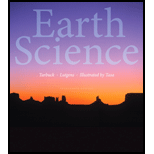
Earth Science (14th Edition)
14th Edition
ISBN: 9780321928092
Author: Edward J. Tarbuck, Frederick K. Lutgens, Dennis G. Tasa
Publisher: PEARSON
expand_more
expand_more
format_list_bulleted
Question
Chapter 24, Problem 1GST
To determine
The order of locations which will encounter its destination from the nearest Earth to the farthest by assuming that NASA is sending a space probe to the following locations:
a. Polaris (the North Star)
b. A comet near the outer edge of our solar system
c. Jupiter
d. The far edge of the Milky Way Galaxy
e. The near side of the Andromeda Galaxy
f. The sun
Expert Solution & Answer
Answer to Problem 1GST
The order of locations (from nearest to farthest) from the Earth is the sun, Jupiter, a comet at the outer edge of the solar system, Polaris, the far edge of the Milky Way, the near side of the Andromeda galaxy.
Explanation of Solution
“A space probe is a robotic spacecraft which explores further into outer space. A space probe may reach the moon, travel through interplanetary space, orbit, flyby, or land on other planetary bodies, or enter interstellar space.”
- a) Polaris – Polaris is commonly known as the North Star or Pole Star. It is the brightest star in the constellation of Ursa Minor. The distance from the Earth to Polaris is about 433 light-years.
- b) A comet near the outer edge of our solar system – The comet is probably from the Oort cloud which starts at 1000 AU from the sun. The outer edge of the solar system is beyond Pluto; there is an imaginary sphere called the Heliopause. It is about 100 AU away from the sun.
- c) Jupiter – It is the largest planet and is located in the fifth position in our solar system. It is one of the gas giants. The distance from the Earth to Jupiter is 4.2 AU.
- d) The far edge of the Milky Way Galaxy – The Milky Way galaxy is a spiral galaxy containing stars and interstellar matter with a bulge in the center, having a concentration of old stars. The disk has spiral arms extending outward from its central bulge. The sun is not the central part of the Milky Way galaxy. Hence, appropriate distance from the sun to the outer edge of the Milky Way is approximately 30,000 light years.
- e) The near side of the Andromeda Galaxy – The Andromeda Galaxy is a spiral galaxy approximately 2.5 million light-years from the Earth and the nearest major galaxy to the Milky Way.
- f) The sun – It is a star and the center of the Solar system where all the planets and other celestial bodies revolve around its central axis. Its distance from the Earth is 149.6 million km or 1 AU.
Want to see more full solutions like this?
Subscribe now to access step-by-step solutions to millions of textbook problems written by subject matter experts!
Chapter 24 Solutions
Earth Science (14th Edition)
Ch. 24.1 - Prob. 1CCCh. 24.1 - Prob. 2CCCh. 24.1 - Prob. 3CCCh. 24.1 - Prob. 4CCCh. 24.2 - Prob. 1CCCh. 24.2 - Prob. 2CCCh. 24.2 - Prob. 3CCCh. 24.2 - Prob. 4CCCh. 24.3 - Prob. 1CCCh. 24.3 - Prob. 2CC
Ch. 24.3 - Prob. 3CCCh. 24.4 - Prob. 1CCCh. 24.4 - Prob. 2CCCh. 24.4 - Prob. 3CCCh. 24.4 - Prob. 4CCCh. 24.5 - Prob. 1CCCh. 24.5 - Prob. 2CCCh. 24.5 - Prob. 3CCCh. 24.5 - Prob. 4CCCh. 24.5 - Prob. 5CCCh. 24.6 - Prob. 1CCCh. 24.6 - Prob. 2CCCh. 24.6 - Prob. 3CCCh. 24.7 - Prob. 1CCCh. 24.7 - Prob. 2CCCh. 24.7 - Prob. 3CCCh. 24.7 - Prob. 4CCCh. 24 - Prob. 1GSTCh. 24 - Prob. 2GSTCh. 24 - Prob. 3GSTCh. 24 - Prob. 4GSTCh. 24 - Prob. 5GSTCh. 24 - Prob. 6GSTCh. 24 - Prob. 7GSTCh. 24 - Prob. 8GSTCh. 24 - Prob. 1EQCh. 24 - Prob. 2EQCh. 24 - Prob. 3EQ
Knowledge Booster
Recommended textbooks for you
 Applications and Investigations in Earth Science ...Earth ScienceISBN:9780134746241Author:Edward J. Tarbuck, Frederick K. Lutgens, Dennis G. TasaPublisher:PEARSON
Applications and Investigations in Earth Science ...Earth ScienceISBN:9780134746241Author:Edward J. Tarbuck, Frederick K. Lutgens, Dennis G. TasaPublisher:PEARSON Exercises for Weather & Climate (9th Edition)Earth ScienceISBN:9780134041360Author:Greg CarbonePublisher:PEARSON
Exercises for Weather & Climate (9th Edition)Earth ScienceISBN:9780134041360Author:Greg CarbonePublisher:PEARSON Environmental ScienceEarth ScienceISBN:9781260153125Author:William P Cunningham Prof., Mary Ann Cunningham ProfessorPublisher:McGraw-Hill Education
Environmental ScienceEarth ScienceISBN:9781260153125Author:William P Cunningham Prof., Mary Ann Cunningham ProfessorPublisher:McGraw-Hill Education Earth Science (15th Edition)Earth ScienceISBN:9780134543536Author:Edward J. Tarbuck, Frederick K. Lutgens, Dennis G. TasaPublisher:PEARSON
Earth Science (15th Edition)Earth ScienceISBN:9780134543536Author:Edward J. Tarbuck, Frederick K. Lutgens, Dennis G. TasaPublisher:PEARSON Environmental Science (MindTap Course List)Earth ScienceISBN:9781337569613Author:G. Tyler Miller, Scott SpoolmanPublisher:Cengage Learning
Environmental Science (MindTap Course List)Earth ScienceISBN:9781337569613Author:G. Tyler Miller, Scott SpoolmanPublisher:Cengage Learning Physical GeologyEarth ScienceISBN:9781259916823Author:Plummer, Charles C., CARLSON, Diane H., Hammersley, LisaPublisher:Mcgraw-hill Education,
Physical GeologyEarth ScienceISBN:9781259916823Author:Plummer, Charles C., CARLSON, Diane H., Hammersley, LisaPublisher:Mcgraw-hill Education,

Applications and Investigations in Earth Science ...
Earth Science
ISBN:9780134746241
Author:Edward J. Tarbuck, Frederick K. Lutgens, Dennis G. Tasa
Publisher:PEARSON

Exercises for Weather & Climate (9th Edition)
Earth Science
ISBN:9780134041360
Author:Greg Carbone
Publisher:PEARSON

Environmental Science
Earth Science
ISBN:9781260153125
Author:William P Cunningham Prof., Mary Ann Cunningham Professor
Publisher:McGraw-Hill Education

Earth Science (15th Edition)
Earth Science
ISBN:9780134543536
Author:Edward J. Tarbuck, Frederick K. Lutgens, Dennis G. Tasa
Publisher:PEARSON

Environmental Science (MindTap Course List)
Earth Science
ISBN:9781337569613
Author:G. Tyler Miller, Scott Spoolman
Publisher:Cengage Learning

Physical Geology
Earth Science
ISBN:9781259916823
Author:Plummer, Charles C., CARLSON, Diane H., Hammersley, Lisa
Publisher:Mcgraw-hill Education,